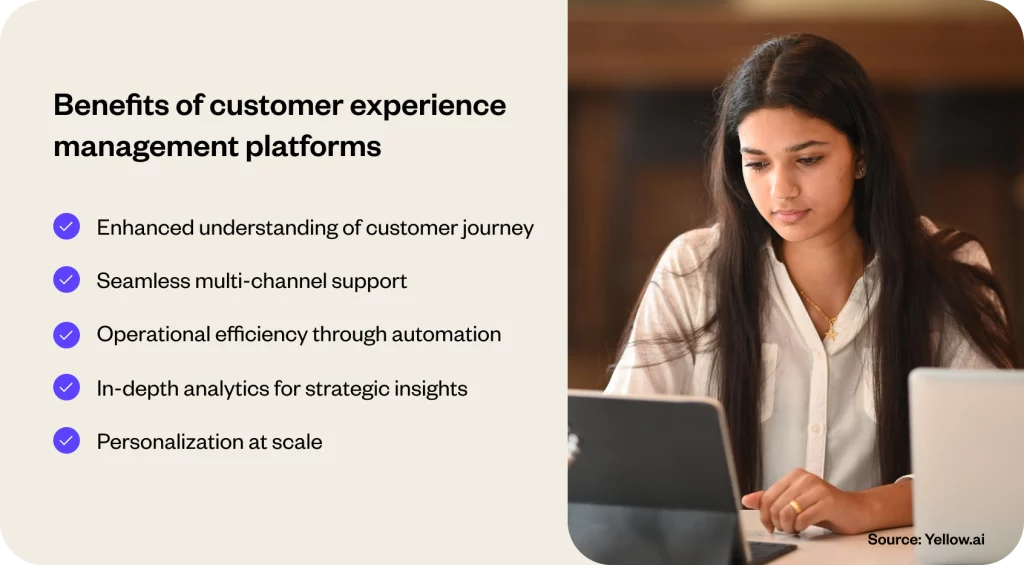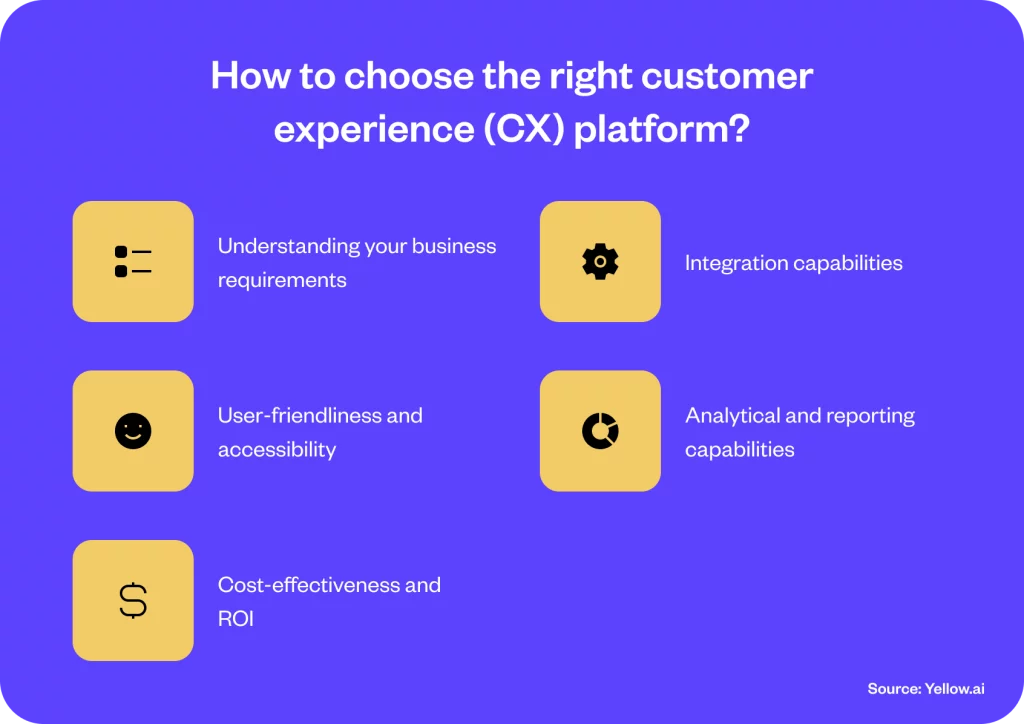Executive summary
Customer experience software is a critical tool for enhancing engagement and satisfaction in today’s ever-evolving business technology landscape. This blog explains the importance of customer experience management software and highlights 11 leading solutions set to dominate the market in 2024. From comprehensive journey mapping and real-time analytics to seamless integration and personalized service delivery, discover how these platforms can transform your customer interactions and drive business growth.
In a marketplace where every interaction counts, the power of customer experience software becomes evident. It is the secret sauce for businesses striving to convert every customer engagement into a stepping stone toward loyalty. The emphasis has shifted from merely tracking customer interactions to crafting memorable experiences, turning satisfied customers into advocates for your brand. As we move into 2024, the landscape of customer experience software is more vibrant than ever. It offers innovative solutions that promise to meet and exceed customer expectations.
Why is this shift critical? The numbers speak volumes: businesses focused on optimizing customer experience see significant benefits in retention and revenue. With an overwhelming 72% of companies now placing customer experience at the heart of their strategy, the message is clear. Success lies in understanding and acting on customer needs in real-time, a goal that today’s leading customer experience platforms are equipped to achieve. Read on as we explore the tools that are game-changers, ready to elevate your customer service and set your brand apart.
Related must-reads:
- 10 key customer experience (CX) trends [2024]
- 10 Essential customer experience KPIs & metrics [2024]
- Customer experience in banking: Importance, examples, and trends for 2024
- Customer experience in retail: Strategies and the future of CX
What is customer experience software?
Customer experience software, often referred to as CX software, acts as the central hub for orchestrating all interactions a customer has with a business. This technology platform enables organizations to track, oversee, and optimize the customer journey across various touchpoints. It ensures a seamless and cohesive experience. A CX software helps gather and analyze data from multiple channels – whether that’s through direct communication, social media interactions, or feedback forms. It gives businesses a 360-degree view of the customer’s journey.
At its core, CX software empowers businesses to understand their customers deeply. By leveraging integrated data analytics and customer feedback, companies can identify patterns, preferences, and areas for improvement. This insight allows for the delivery of personalized experiences that address individual customer needs and expectations. Such personalization often exceeds customer expectations, fostering loyalty and encouraging repeat business.
The significance of adopting customer experience software today cannot be understated. In an era where customer expectations are continually evolving, businesses that leverage customer experience (CX) software position themselves to respond dynamically to these changes. It’s not merely about resolving customer issues but proactively enhancing the overall experience, which in turn drives growth and competitiveness. Businesses looking towards customer experience (CX) software today aim to build lasting relationships with their customers and transform one-time buyers into lifelong advocates.
Benefits of customer experience management platforms
Customer experience management (CEM) platforms are essential strategic assets for businesses aiming to elevate customer satisfaction and foster loyalty. By intricately weaving together data, interactions, and customer insights, these platforms offer various benefits tailored to propel businesses forward. Let’s explore the advantages of integrating a customer experience management platform into your business operations.

Enhanced understanding of customer journey
A core benefit of Customer experience management (CEM) platforms is their ability to map the customer journey comprehensively. It gives businesses a clear vision of the customer’s experience from initial contact to post-purchase. This visibility allows companies to pinpoint critical interaction points that shape the customer’s perception and identify opportunities for improvement. The impact? A tailored approach that meets customers at every turn. It ensures their journey is satisfactory and memorable, thereby increasing brand loyalty and fostering long-term relationships.
Seamless multi-channel support
In an age where customers engage across multiple platforms, Customer experience management (CEM) platforms shine by offering seamless multi-channel support. This integration ensures that the quality of service remains consistent whether a customer reaches out via social media, email, or live chat. The ability to provide a cohesive experience across various channels boosts customer satisfaction and streamlines the workload for support teams. That makes it easier to manage and respond to inquiries efficiently.
Related read: Seamless omnichannel CX: Your step-by-step guide
Operational efficiency through automation
Automation stands out as one of the most significant benefits offered by Customer experience management (CEM) platforms. By automating routine tasks such as ticket routing, response templating, and follow-ups, these platforms free up valuable time for customer service teams to focus on more complex queries that require a human touch. Automation enhances operational efficiency and also ensures customers receive timely, accurate responses. That further enhances their overall experience with your brand.
In-depth analytics for strategic insights
CEM platforms provide businesses with in-depth analytics and reporting tools that transform raw data into actionable insights. By analyzing customer behavior, feedback, and engagement metrics, businesses can make informed decisions that align with their customers’ needs and expectations. These insights are invaluable for refining customer experience strategies, optimizing service delivery, and ultimately driving business growth through improved customer retention and acquisition.
Personalization at scale
Finally, CEM platforms excel in enabling personalization at scale. By leveraging customer data and insights, businesses can tailor their interactions and services to meet the unique needs and preferences of each customer. Personalization enhances the customer’s experience by making them feel valued and understood, which is crucial in today’s competitive market. The ability to personalize at scale boosts customer satisfaction and also encourages loyalty and advocacy, which contributes to the long-term success of the business.
Pelago reimagines customer experience with generative AI powered automation

The best customer experience software platform in 2024
As businesses continue to navigate the complexities of customer engagement in an increasingly digital world, selecting the right customer experience (CX) software becomes paramount. The landscape of CX software in 2024 is diverse, with platforms designed to meet various needs, from analytics to engagement and integration. Here’s a look at the top contenders shaping how businesses connect with their customers.

1. Yellow.ai
Yellow.ai stands at the zenith of customer experience innovation, offering a dynamic platform that seamlessly blends artificial intelligence with human empathy. As a pioneer in AI-driven customer engagement and customer service automation, Yellow.ai empowers businesses to deliver personalized, conversational experiences across various channels. With its robust features, including AI-powered chatbots and voice agents, omnichannel integration, LLM-powered email automation, and real-time analytics, Yellow.ai transforms every customer interaction into a delightful journey, driving loyalty and growth. The platform’s unique ability to understand and adapt to customer needs ensures that businesses can offer a proactive, rather than reactive, customer experience.
- Omnichannel agility: Effortlessly connect with customers across any platform, from email, voice interaction, and social media to web chat, ensuring a unified and coherent customer journey.
- AI-powered insights: Leverage cutting-edge AI to glean insights from customer interactions, enabling personalized experiences at scale.
- Automated efficiency: Streamline customer service operations with intelligent automation, from customer queries to feedback collection, enhancing responsiveness, experience, and satisfaction.
Success stories

Indigo boosts customer satisfaction
Learn how Indigo boosts customer satisfaction to 87% with AI automation

Hyundai boosts revenue and improves customer service with AI automation
Explore how Yellow.ai’s automation led to ~1000 car sales, a 10% retail conversion rate, and over 1.4 million user impressions

Pelago reimagines customer experience with generative AI powered conversational AI agents
Within a mere six weeks of going live, Pelago not only onboarded over 5,000 users but also achieved a striking 50% deflection rate!
2. Help Scout
Focused on fostering genuine connections, Help Scout provides tools that facilitate humanized and direct conversations with customers. Its simplicity and efficiency make it a favorite among businesses aiming to elevate their customer service game without compromising on the personal touch.
3. Zendesk
Zendesk is synonymous with comprehensive customer support, offering a powerful and user-friendly suite. Its flexibility and scalability make it a go-to for businesses of all sizes looking to manage customer interactions across any channel effortlessly.
4. Adobe Experience Manager
Part of Adobe’s formidable Experience Cloud, Adobe Experience Manager excels in content management and digital asset management, enabling businesses to craft personalized, dynamic customer experiences across every touchpoint.
5. Drift
Drift is at the forefront of conversational marketing and sales, offering AI-driven tools that facilitate real-time engagements and transform the way businesses connect with their customers. It makes every conversation count toward building stronger relationships.
6. MoEngage
An insights-led customer engagement platform, MoEngage empowers brands to understand and respond to customer needs with precision and personalization. Its strength lies in creating meaningful, data-driven interactions across the customer lifecycle.
7. Copper CRM
Copper CRM reimagines relationship management by seamlessly integrating with users’ workflows, particularly those within the Google Workspace ecosystem, making it an indispensable tool for teams prioritizing efficiency and connectivity.
8. Qualaroo
Qualaroo specializes in user research and feedback, leveraging AI to unlock deep insights into customer behavior and sentiment. Its nuanced approach to gathering feedback makes it a powerful ally in enhancing the customer experience.
9. Hotjar
With a focus on understanding how users interact with websites and products, Hotjar’s suite of analytics and feedback tools provides invaluable insights into customer behavior, enabling businesses to make data-driven decisions that enhance user experiences.
10. Reputation
Reputation masters the art of online review management, offering businesses a comprehensive platform to monitor, respond to, and leverage customer feedback across numerous review sites and social media platforms.
11. Sprout Social
Sprout Social enriches customer experiences through advanced social media management, enabling brands to listen, engage, and grow their audience across platforms with strategic, data-informed interactions.
See the difference in your CX with next-gen AI-powered automation

Things to look for in a customer experience management solution
In the dynamic fields of business technology, customer experience management (CXM) platforms stand out as indispensable tools. They help craft meaningful customer journeys and foster brand loyalty. Identifying the right features in a CXM solution is crucial for businesses aiming to exceed customer expectations. Let’s explore the essential elements to consider.

1. Unified data collection across all channels
The cornerstone of an effective CXM strategy is the capability to aggregate data across all customer interaction points. Whether it’s feedback from social media, direct communication, or indirect mentions, a comprehensive CXM solution captures every snippet of customer discourse. This integrated approach ensures no insight is overlooked, providing a holistic view of the customer experience.
Unified data collection empowers businesses to paint a complete picture of their customer interactions. It enables them to identify trends, preferences, and areas needing improvement. By centralizing data, companies can ensure consistency in customer engagement across all platforms. That leads to more personalized and effective customer service strategies.
2. Comprehensive journey mapping through data capture
Journey mapping is pivotal in understanding the nuances of the customer experience. A robust CXM platform captures data at each customer touchpoint and also contextualizes this information to reveal the customer’s path from awareness to loyalty. This insight allows businesses to tailor their strategies to address specific customer needs at each stage of their journey.
Effective journey mapping provides actionable insights into customer behavior and preferences, enabling businesses to optimize touchpoints for enhanced satisfaction. It helps in identifying friction points and opportunities for engagement, ultimately guiding customers toward a more fulfilling interaction with the brand.
3. Insightful dashboards with real-time analytics
In the fast-paced digital world, real-time analytics are invaluable. An efficient CXM solution offers dynamic dashboards that deliver up-to-the-minute insights into customer interactions and satisfaction levels. These dashboards should be customizable to suit different roles within the organization, providing relevant data to inform decision-making processes.
Real-time analytics allow businesses to react promptly to emerging customer trends and issues, ensuring that customer needs are addressed efficiently. Insightful dashboards serve as a navigational tool for continuous improvement, guiding companies toward data-driven strategies that enhance the overall customer experience.
4. Data-driven recommendations for enhanced strategies
Beyond collecting and analyzing data, a top-tier CXM platform leverages this information to provide strategic recommendations. By utilizing AI and machine learning, these solutions can predict customer behavior, identify cross-sell and upsell opportunities, and suggest improvements to customer service protocols.
Data-driven recommendations equip businesses with the foresight to proactively address customer needs, personalize interactions, and optimize their service offerings. This proactive approach improves customer satisfaction and drives business growth through targeted, effective engagement strategies.
5. Seamless integration with existing technology ecosystems
For a CXM solution to be truly effective, it must integrate seamlessly with a company’s existing technology stack. It includes CRM systems, marketing automation tools, and data analytics platforms. A well-integrated CXM solution enhances data fluidity, ensuring that customer insights are accessible across all business functions.
Seamless integration facilitates a unified approach to customer experience management, breaking down silos and fostering collaboration across departments. It enables businesses to leverage their existing technological investments to their fullest potential, creating a cohesive and comprehensive CX strategy.
How to choose the right customer experience (CX) platform?
The quest for the ideal customer experience (CX) platform is akin to navigating a complex maze filled with numerous paths and decisions. As businesses strive to provide unparalleled customer service, choosing a CX platform that aligns with their unique needs becomes imperative. Here’s a strategic approach to making this critical choice.

Understanding your business requirements
Choosing the perfect CX platform demands a deep dive into the intricacies of your business’s operational landscape. It’s about mapping out the volume of your customer interactions, the diversity of engagement channels, and the scalability required to accommodate future expansions. Opt for a platform that garners comprehensive customer insights and also has the agility to grow as you do. That ensures it is a perfect fit for your unique business ecosystem.
A CX platform that mirrors your business requirements ensures that you are not over-investing in unnecessary features or under-prepared for future growth. It enables a tailor-fit solution that maximizes efficiency and effectiveness in managing customer experiences.
Integration capabilities
In today’s digital ecosystem, a CX platform’s ability to integrate seamlessly with your existing software stack is non-negotiable. Whether it’s your CRM, ERP, or marketing automation tools, the chosen platform should offer smooth integration, ensuring a unified approach to customer data and insights.
Seamless integration reduces operational silos and enhances data fluidity across departments. Besides improving internal collaboration, it also ensures that every customer interaction is informed by comprehensive data, leading to more personalized and effective customer engagements.
User-friendliness and accessibility
A CX platform’s ease of use is crucial for ensuring that your team can leverage its full potential. A platform with an intuitive interface and straightforward navigation minimizes the learning curve and enhances user adoption across your organization.
The more accessible a CX platform is, the more likely your team will utilize its features to the fullest. It leads to improved efficiency in managing customer experiences and ensures that your investment in the platform translates into tangible benefits.
Analytical and reporting capabilities
Understanding customer behavior and preferences is the key to improving customer experience. Opt for a CX platform that offers robust analytical and reporting tools that can deliver actionable insights into customer interactions across all touchpoints.
With data-driven insights at your disposal, you can make informed decisions that enhance customer satisfaction and loyalty. These tools allow businesses to identify trends, monitor performance, and adjust strategies in real-time, ensuring a continuously optimized customer experience.
Cost-effectiveness and ROI
When selecting a CX platform, it is paramount to weigh its cost against the strategic value it delivers. Look beyond the upfront investment to the broader spectrum of benefits it offers, including bolstering customer loyalty, enhancing satisfaction, and fueling business expansion.
Investing in a CX platform that offers a positive ROI ensures that your resources are being allocated efficiently, leading to sustainable growth and a competitive edge in customer experience management.
How does Yellow.ai help to reimagine customer experience management?
As businesses strive to navigate the evolving landscape of customer expectations, Yellow.ai emerges as a transformative solution in the realm of customer experience software. Its innovative use of artificial intelligence is redefining how businesses engage with their customers, offering a suite of features that cater to the dynamic needs of today’s digital consumer. Yellow.ai customer service automation is revolutionizing leading enterprises across sectors to ameliorate their customers’ experience beyond imagination.
Key features of Yellow.ai
- Stay accessible around the clock: Provide 24/7 customer service with our AI-powered chatbots and voice agents. They enhance customer experience by understanding and responding to queries with human-like empathy and efficiency.
- Omnichannel integration: Seamlessly interact with customers across multiple platforms, ensuring a unified and cohesive experience no matter where the conversation takes place.
- Advanced analytics: Gain deep insights into customer behavior and preferences, enabling data-driven decisions to enhance the customer experience.
- Personalization at scale: Use AI to tailor interactions based on individual customer data, delivering personalized experiences that increase satisfaction and loyalty.
To see how Yellow.ai can transform your customer experience management, book a demo today and step into the future of CX innovation.
The final thoughts
In an era defined by customer expectations, mastering the art of customer experience is essential. CX software’s critical role in crafting experiences to meet and exceed customer expectations is no longer a secret. The landscape of CX software in 2024 offers various options, each with its strengths and capabilities. However, the accurate measure of success lies in choosing a platform that resonates with your unique business needs, amplifies your strengths, and transforms challenges into opportunities for growth.
As we look towards the future, remember that the tools and technologies we embrace today will shape the customer relationships of tomorrow. Investing in the right CX platform is a commitment to excellence, innovation, and the endless pursuit of creating customer experiences that leave a lasting impression.
Frequently asked questions (FAQs)
How does customer experience software improve customer satisfaction?
Customer experience software significantly enhances customer satisfaction by offering a streamlined, personalized approach to customer service. By aggregating data from various touchpoints, these platforms provide a comprehensive view of the customer journey, allowing businesses to anticipate needs, resolve issues proactively, and tailor interactions to individual preferences. This level of attentiveness and personalization fosters a sense of value and satisfaction among customers, leading to increased loyalty and positive word-of-mouth.
What features should I look for in customer experience software?
Key features to seek in customer experience software include omnichannel support, AI-driven insights and automation, comprehensive data analytics, personalized interaction capabilities, and seamless integration with existing technology stacks. These features ensure that businesses can offer consistent, efficient, and customized experiences across all customer interactions, ultimately driving satisfaction and loyalty.
What is the ROI of investing in customer experience software?
The return on investment (ROI) of customer experience software is multi-faceted, encompassing increased customer satisfaction, higher retention rates, more excellent customer lifetime value, and enhanced brand reputation. By improving the efficiency of customer service operations and enabling personalized, proactive engagement, businesses can significantly reduce churn and boost upsell and cross-sell opportunities. It, in turn, leads to sustainable business growth and a competitive advantage in the marketplace.























